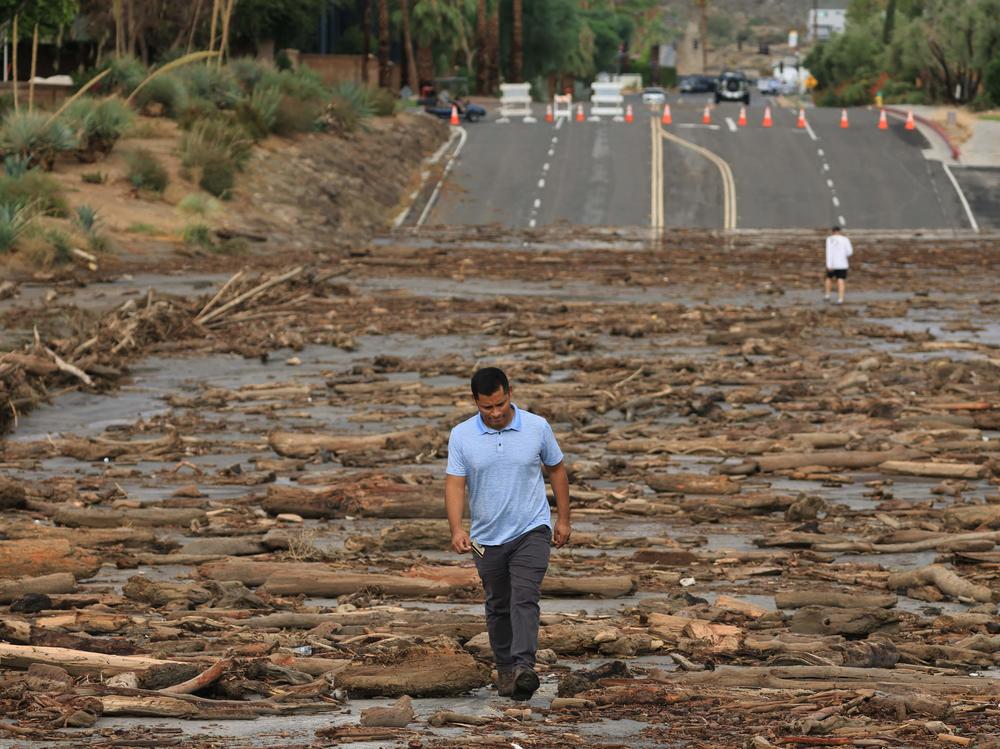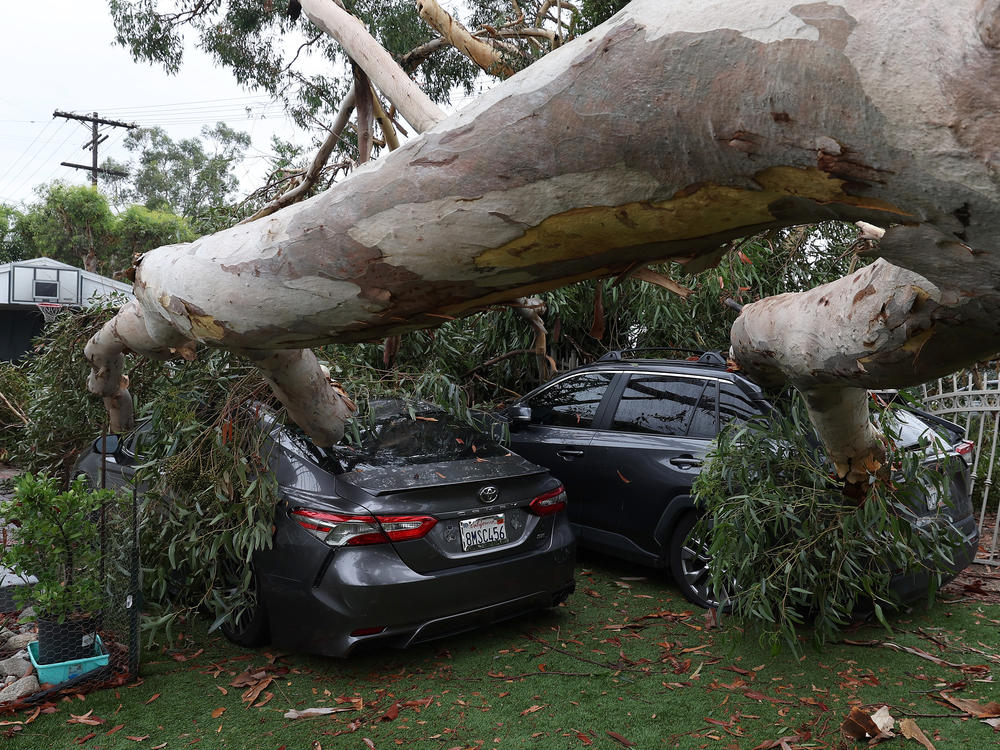Section Branding
Header Content
Tropical Storm Hilary moves on from California, leaving a trail of damage and debris
Primary Content
Hilary, the first tropical storm to hit Southern California in over 80 years, began to dissipate on Monday after walloping the region with record-breaking rainfall.
The storm is moving on to Nevada with less vigor after leaving millions of California residents under flood risk warnings, causing thousands of homes and businesses to lose power and shutting down major school districts.
The storm dropped as much as 7 inches of rainwater in some mountain regions and up to 4 inches in lower-lying areas as it moved from northern Baja California in Mexico into the United States, drenching California along the coast, in the mountains and in the Coachella Valley, home to the desert city of Palm Springs.
The National Weather Service Los Angeles said at 3 a.m. local time that the storm had broken "virtually all rainfall daily records." A record rainfall of 2.48 inches was set in downtown Los Angeles, breaking the previous record of 0.03 set in 1906.
Early Monday, officials reclassified the storm as a post-tropical cyclone and forecast it would travel north through Nevada, posing more flood risks. But as of midday Monday, the damage appeared to be less than originally feared.
One storm-related death was reported in Mexico
"It seems like the public largely heard the message to prepare ahead of time and stay home, which helped a lot," LAist reporter Erin Stone told Morning Edition on Monday. "So that old adage 'better safe than sorry' seems to have been the wisdom of the weekend."
But emergency responders did have to rescue and evacuate dozens of people, including from a mobile home park in the Coachella Valley and a homeless encampment along the San Diego River.
An estimated 75,000 LA County residents don't have access to a permanent home or shelter, and advocates say they remain at an exponentially higher risk of being injured or killed by floodwaters, falling debris and hypothermia.
While California officials hadn't reported any fatalities as of Monday morning, Mexican authorities have linked one death to the storm.
The mayor of Santa Rosalía said one person died after a family's vehicle was swept away Saturday night, The New York Times reports.
Storm damage caused some cities to lose 911 access and led to school closures
Three California cities — Cathedral City, Indio and Palm Springs — all reported downed 911 lines on Sunday evening due to damage from the storm.
In Palm Springs, a news release urged residents to call nonemergency lines or text the 911 number to reach the nearest fire or police station. The city declared a local emergency on Sunday after flooding washed out roads and closed the area's major freeway, the I-10, in both directions.
A nearby hospital, Eisenhower Health in Rancho Mirage, Calif., saw its ambulance bay flooded and was running on a single backup generator.
Concerns for transportation hazards amid high wind speeds led the Los Angeles Unified School District, the country's second largest, to close all campuses and cancel after-school programs for the day.
Districts in San Diego, Pasadena and Coachella Valley were also closed as of Monday, collectively impacting over half a million students — including some who were anticipating their first day back after summer vacation.
A 5.1 magnitude earthquake shook Southern California as rain fell
According to poweroutage.us, over 47,100 homes and businesses were without power as of Monday midday.
But in a sign of the state's colliding natural disasters, over 12,000 of those outages were coming from Del Norte County in the northwest corner of the state, an area where the storm's impact was minimal. The power lines had been shut off for a much more familiar reason: to minimize the impact of an approaching wildfire, local news outlets reported.
In a similar way, just as the usual summer storm was making landfall, Southern California experienced a highly familiar phenomenon: a magnitude 5.1 earthquake struck the area. The term "hurriquake" took off on social media.
The earthquake's epicenter was registered along the Sisar fault in Ojai, which is located between Santa Barbara and Ventura, according to the U.S. Geological Survey. The Ventura County Sheriff's Office and Los Angeles Fire Department both reported no immediate damage or injuries.
Experts say we should expect more tropical storms this season
It's not just Hilary: Three tropical storms are churning over the Atlantic Ocean at the moment, with a fourth looking possible in the Gulf of Mexico amid a spate of thunderstorms.
Tropical Storm Franklin, currently in the Caribbean Sea, is expected to bring strong winds and heavy rainfall to Puerto Rico throughout the middle of the week. Two other storms — Emily and Gert — are moving through the open Atlantic and don't appear poised to make landfall.
We still haven't reached the peak of what's expected to be an above-average hurricane season. In a midseason forecast, the National Oceanic and Atmospheric Administration predicted 14 to 21 named storms and six to 11 hurricanes, both predictions up substantially from the original season forecast released in May.
Hurricanes are more likely to be larger and more powerful when they form over hotter ocean water, and the ocean is a lot warmer than usual this summer.
Forty percent of the world's oceans are experiencing heat waves right now, according to federal researchers, in part due to a natural climate pattern called El Nino and human-caused climate change.
Part of the ocean that Hurricane Hilary formed over is around Baja California, Mexico, in the Pacific. Temperature anomalies there are part of what's been fueling this storm, says UCLA climate scientist Daniel Swain.
"The ocean temperatures off the coast of Baja California are much warmer than usual right now," Swain says. "As much as 3 to 6 Fahrenheit — that's a pretty significant increment of additional hurricane fuel."
NPR's Peter Granitz and Julia Simon contributed reporting.
This reporting originally appeared in our live blog. Revisit how the news unfolded.
Copyright 2023 NPR. To see more, visit https://www.npr.org.


